https://www.youtube.com/watch?v=c8s6Md4RXqg
Drawing - Creating Animal Characters
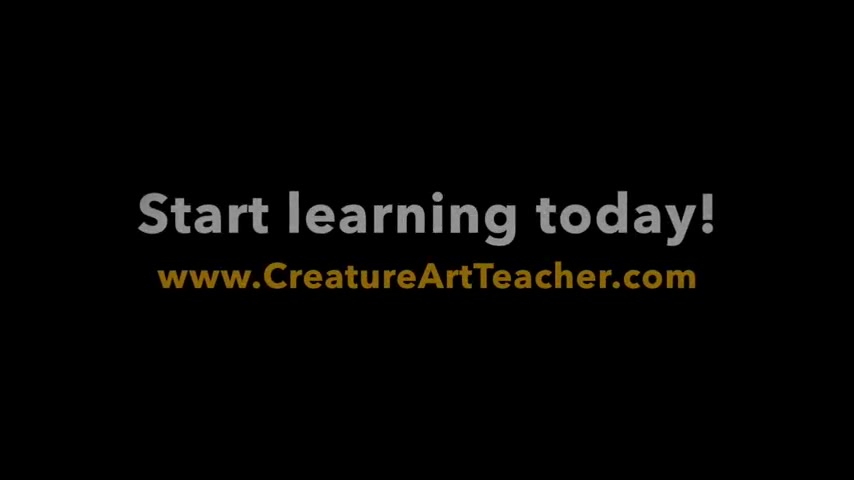
Everybody .
Aaron Blaze here .
And today I thought I would get away from the computer for a little while and come back and get onto my traditional , my good old drawing board , my old Disney desk , my animation desk and I just thought I'd sit down and do a little bit of animal character drawing for you .
Um You know , something I've got a lot of experience doing with Lion King and Brother Bear and , you know , a lot of the other Disney films that I've worked on Aladdin and um uh it's something I really love to do .
And so I thought it would be fun just to sit down and draw .
And I'll just talk about some of the things that I think about when I'm creating animal characters .
Ok ?
And I'm not talking about realistic animals .
I'm talking about making characters out of them .
So , um why don't we just go ahead and dive in ?
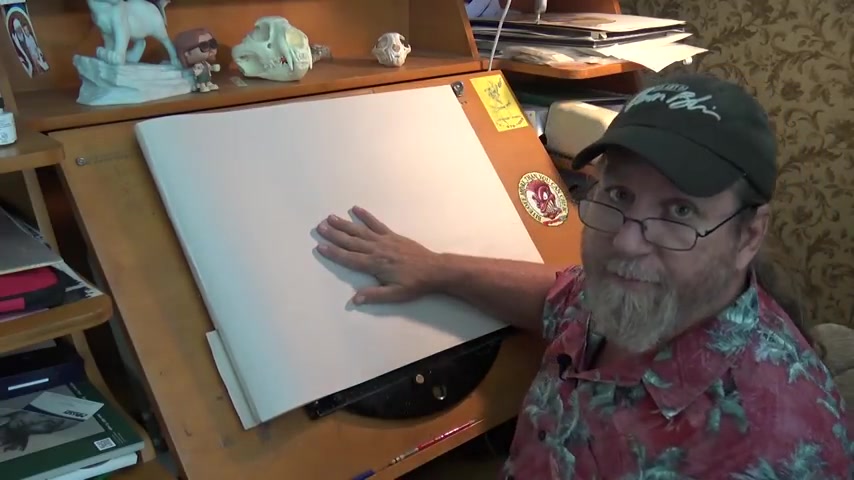
The first thing is I , I like to , you know , when I do this kind of stuff , I like to work on big newsprint .
It's really cheap .
You can get it at any art store .
Uh It's just newsprint paper .
It's the same paper that , you know , your newspaper is made out of .
And then the other thing that I'm using is um this drawing utensils .
It's basically just a holder and I've got uh this one's almost used up , but it's uh this is black pastel , but it's very , very , it's packed very hard .
So it's almost like graphite .
Uh It's almost like a number six or a six B pencil , but it's a pastel and I love to use it .
It's a nice big bold drawing line .
And uh why don't we just go ahead and dive in the first thing .
Let's just start with my go to , I like to draw lions , big cats .
You guys know that .
So I'm just gonna go ahead and start .
Now , the first thing that I think about when I'm doing animal characters is I want to think about personality .
That's the first thing that I want to get down the anatomy and all that stuff I'll talk about in just a minute , but that'll come in later .
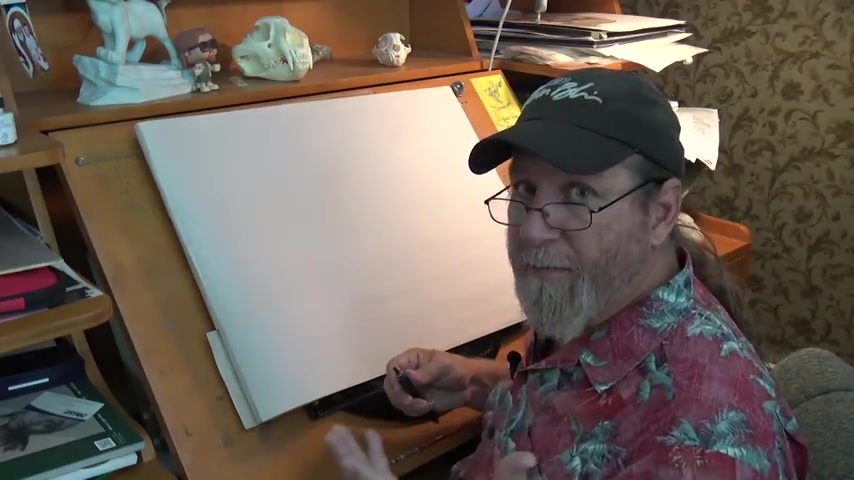
And the other thing I want to talk about and I , that I think about is making sure that I'm getting interesting proportions .
I wanna make sure the biggest killer that I'm always talking about is making sure that you don't have evenness in your drawings .
Evenness is a killer .
And if you think about , think about music , you know , if , if music , if , if you listen to a piece of music and it's just but , but , but , but , but , but that's boring .
But if you can get some , some texture in that , if you can get some unevenness in it , that , that , that , that , that , that , that , you know , that kind of thing , that's more exciting .
That's more interesting .
And that's the same with visual , with um you know , when you're working visually , when you can get some unevenness , when you can get some texture in there , some , some visual texture , then that's , that's where it gets interesting .
So that's the first thing I like to think about is um expression , attitude and making sure that I'm not even .
Um but let's uh I wanna start with a lion .
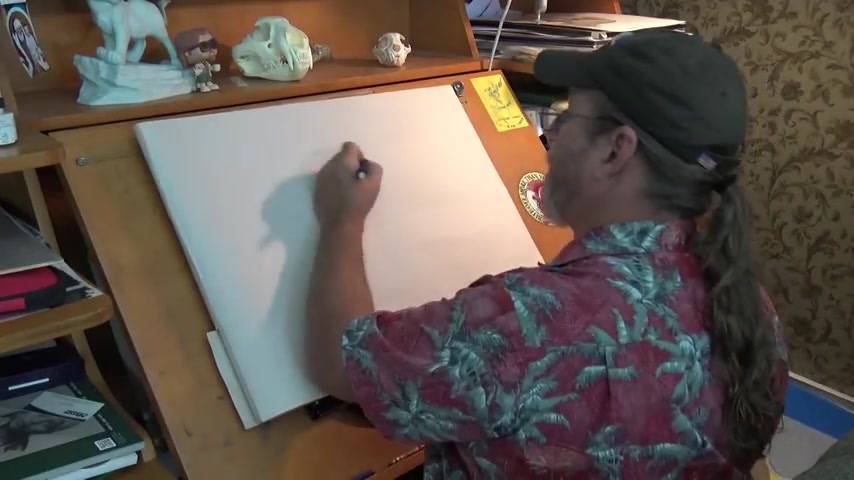
Let's just start with a lion and I want to do , hm , let's see .
Let's have him looking off , maybe he's a little puzzled and you'll see , I'm , I , I start very loose and I want very clear expressions .
So I like to start with the eyes a lot of times I'll get that nose happening in here and you'll see , I'm going for major shapes as well , but here there .
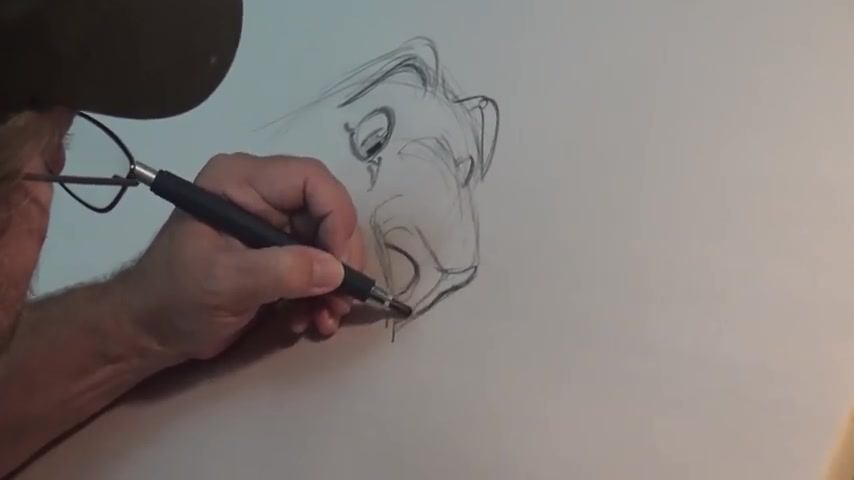
So already you can see and I'm just kind of making this up as we go .
I , I'm thinking about a lion and I'm thinking about the anatomy of a lion .
That's the other thing , you know , um when you're , when you're working on character design , especially with animals , you have to know that anatomy just because you're creating a cartoon , so to speak .
Doesn't mean that you can get away with not knowing the anatomy .
Matter of fact , you need to know it even more because you need to know what you're abstracting .
AAA caricature is an abstraction .
So here I'll have him looking down or her , maybe we'll make it a female , but either way that's coming down and I wanna , I wanna really , I wanna push maybe the size of the face a little bit and get a nice big jaw like , oh look at that .
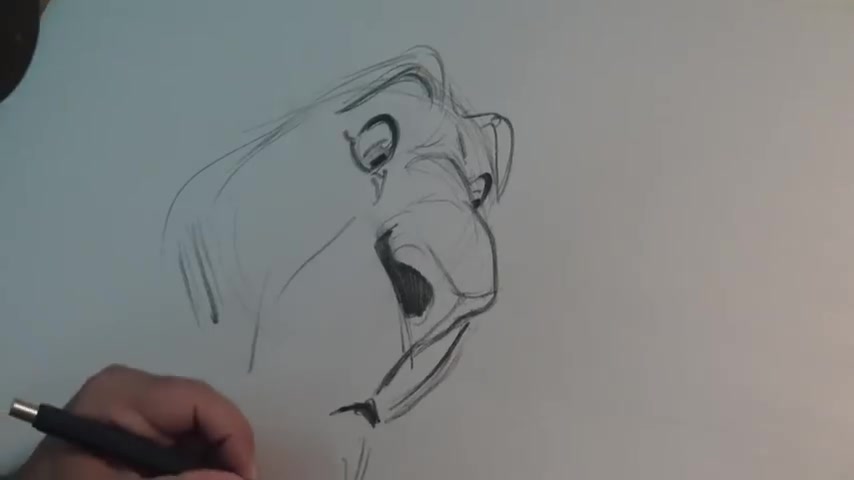
Keep your attitude simple there .
So here I'm trying to go for a nice , simple shape .
Overall , you can see right here and I know that on a lion , you know , if you look at that slope on the nose coming back , that head comes back this way so I can get that brown up nice and high and go for a nice clear expression .
I love drawing big like this .
It's uh it's so much fun now , cats , big cats , you know , we got the cheekbone coming down here and here's a , here's a leopard which is not too dissimilar from a , from a lion .
But uh you know , you've got the bridge of the nose coming down here .
The cartilage is all right here , which is what I'm drawing right here .
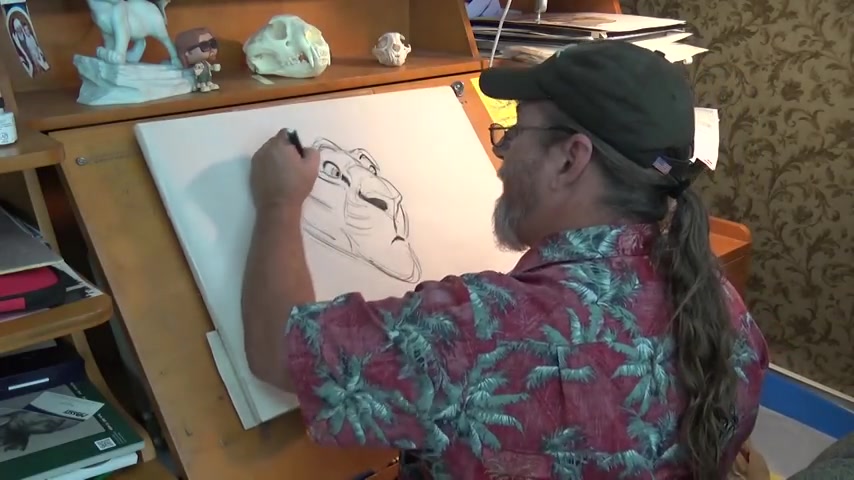
The cheekbones come in which is coming down right here .
The eye sockets are all right in here .
And actually , that's emphasized by the , there's some markings under the eye right there .
On the lion .
There we go .
So I keep in the , the that jaw comes up lots of muscle back in here .
I keep this anatomy even though this is a leopard , I've got lions , I've got a lion up in my bedroom .
Um I keep this anatomy in my head , you know , throughout the entire body .
When I'm caricaturing the body .
I keep all of that in my head as I'm drawing because if you know what you're abstracting from , if you know the reality , then when you create the character , the caricature , then it's that much more believable .
And that's what you want .
You want believability in your characters .
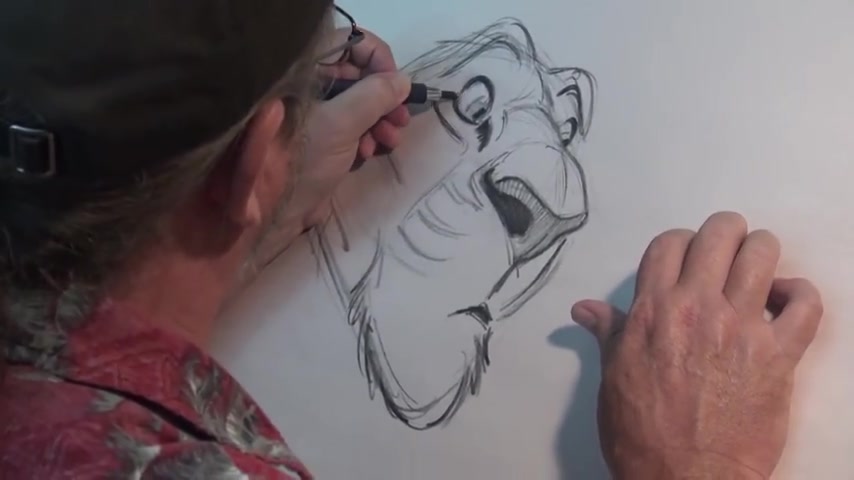
That's what we always shop for at Disney is , you know , we create worlds and we create characters that you can get behind .
And in order to do that , you have to believe that they're there , you have to believe that they're real .
And so not only from a writing standpoint , um but also from a visual standpoint , obviously , from a visual standpoint .
So here's , here's something , you know , somewhat quickly and I know that they have a bunch of fur that comes up in here .
But let's go ahead .
I think I'm gonna go ahead and try , uh I'm gonna try um giving him a make it turn , let's turn it into a male , give him a little bit of a mane .
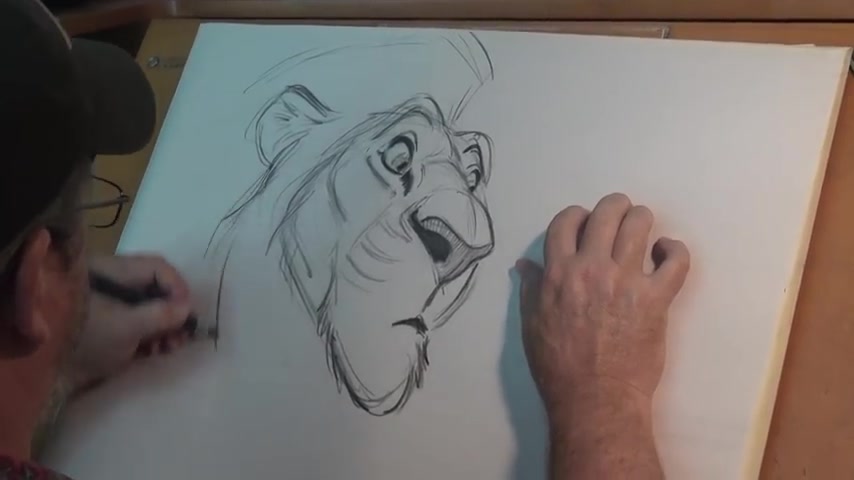
So I think that man would go right off the page now , male lions before you get to that big , the big , the main Maine , the big part of the Maine .
Um , they've got this tuft right here .
A fur that comes around that grows off the jaw .
There we go .
And then that comes back into the main over here .
Let's see what we wanna do .
Oh , the other thing too .
So , so if , if you need to erase , I keep a needed eraser , you know , a gum eraser that I can just stretch and , and play with .
I try not to erase that much .
Not when I'm doing this sort of thing .
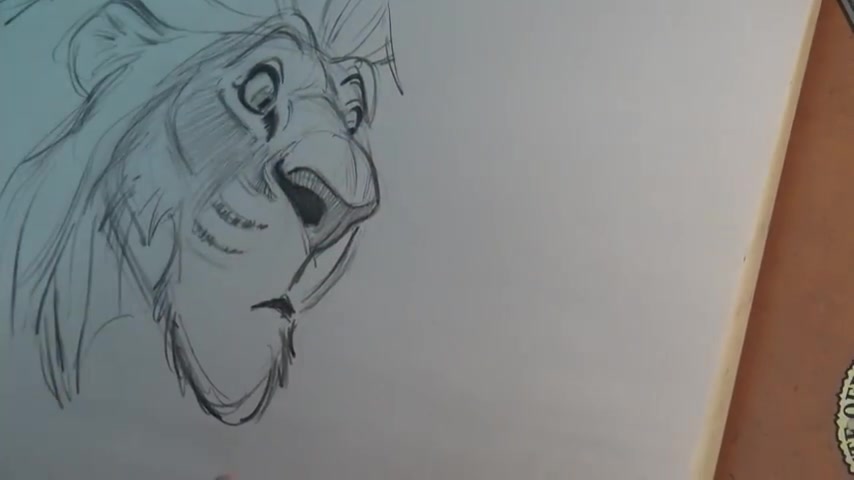
I love , you can see when you draw big .
It's so satisfying .
And I wanna find , I wanna get nice flat edge .
There we go .
I love , love , love drawing big like this , especially when I'm doing character stuff .
It's just , it's so much fun .
Uh especially with pastel and charcoal and you just get in and smear stuff around there .
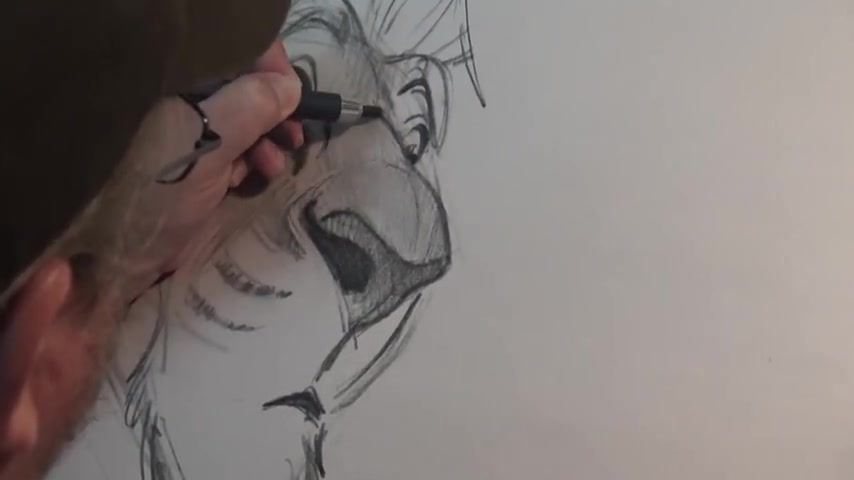
So here I got character kind of surprised and looking off the screen right here and I wanna , I wanna let this nose come out and kind of want the silhouette to be nice and clear .
So I don't wanna , I don't wanna bring that mane down in .
So I think , I think I'll race this back and just let let this come up there .
Just something like that .
There's something quick I'm trying to think of pushing proportions and having some fun with it like that .
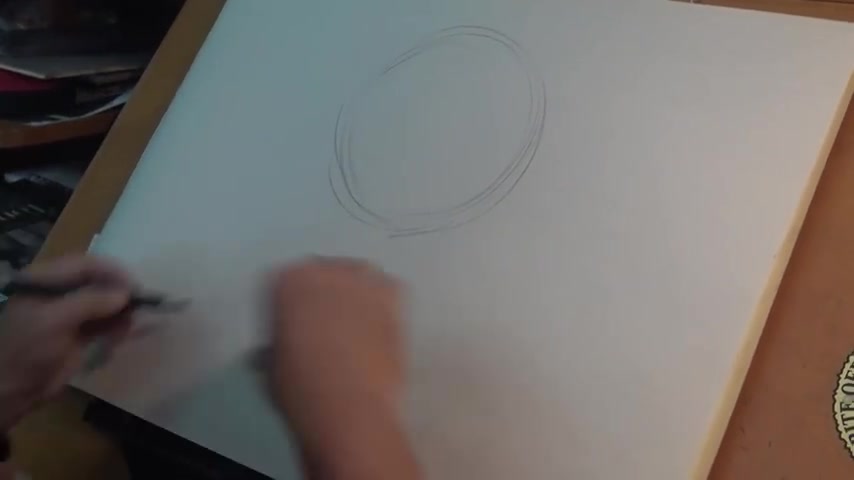
How about a bear I love drawing bears .
Same thing I'll start with .
I like to start with that simple shape .
Now , bears have a different type of nose .
Once again , going back to understanding that anatomy , it's important .
If you look at a dog's nose and a bear's nose , they're very similar dogs and bears are very distantly related .
And so they have similar noses .
But here I'm trying to find a nice , simple way of portraying that .
But here it is , it's Sunday afternoon and it's one of my favorite things to do on a Sunday is just to sit and just sit here and just draw just like when I was a little kid , it's something I love doing .
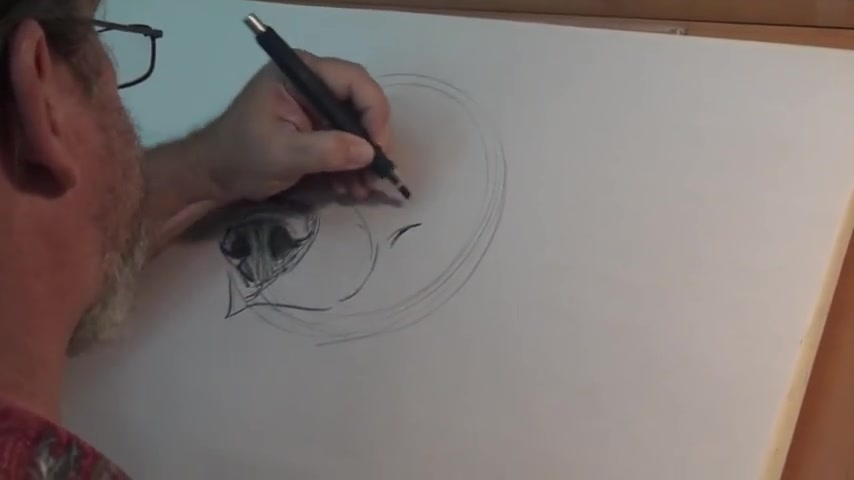
And once again , I want a nice simple expression just like so and they have the same thing .
Here's a , here's a bear skull right here .
Oh , let's see if I can do this without knocking anything over .
But this is a big grizzly bear skull .
And you can see there's that the , the nasal opening that cartilage for the nose goes right over the top of that .
So where that meets the bone , you can see that that shows up here and I like to show that and the drawing , give them some tooths , give them a few teeth there .
But I'm getting detailed already .
I'm getting too detailed , too quick .
So let's go ahead and I wanna go ahead and get his eyes in and that's that , you know , he's smiling .
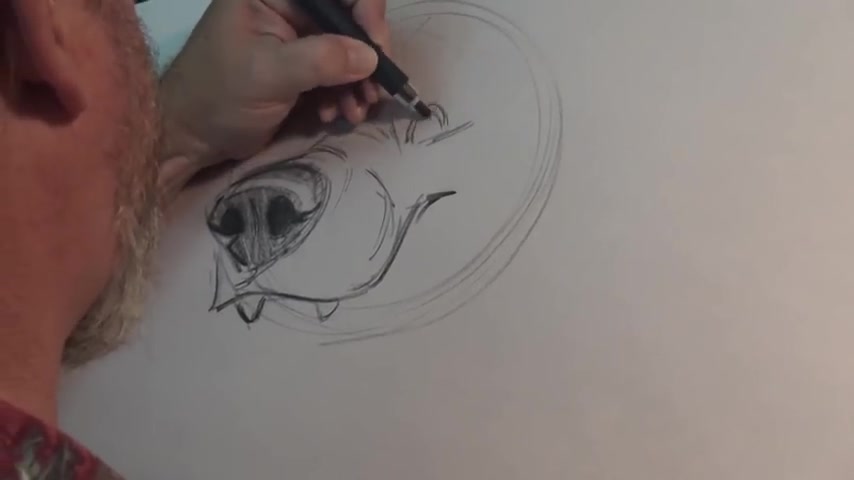
So I'm gonna have him , I'm gonna push his eyes together a little bit and give him a little eyes relative to his head .
I'm gonna have him looking off to the right .
You want clarity , clarity , clarity .
Those is eyelids and here , same thing I wanna , I'm gonna push this brow up and bears have big muscular heads , a bear's jaw , that lower jaw , you know , they , you want to think about when you open a bear , when you open any animal's mouth .
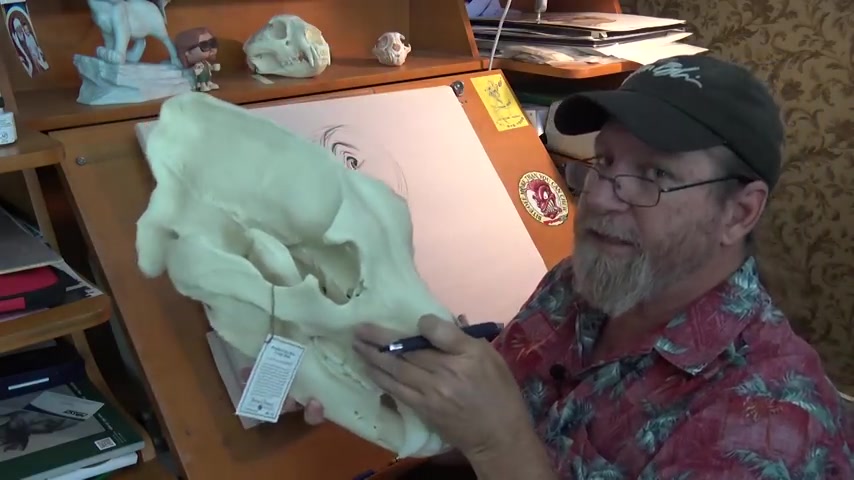
A lot of people make the mistake that they , they make the corners of the mouth , they hinge , that's where it opens .
But you gotta remember the , the opening , you know , the hinge of a jaw is way back behind , you know , back here , it's way back here .
So when you open up a character's mouth , you want to make sure that you get that accurately .
So I'm thinking about that jaw way back here coming down and opening up like that , that's going to feel more accurate .
That's going to make it feel more believable .
Once again , even though we're doing something cartoony , you want to make sure that is believable .
And bears also have these big kind of these big droopy lips on the end .
But the key is , it's just making sure you get good , strong attitude .
I want to make sure that the attitude is clear .
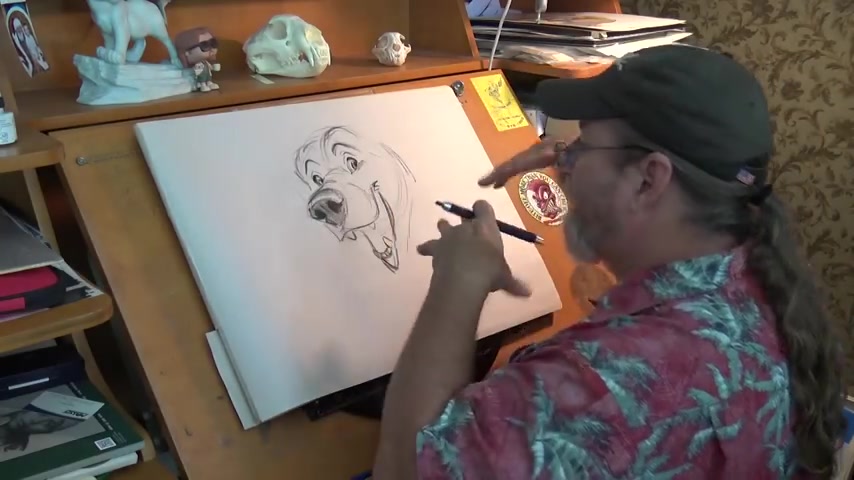
So that's why , you know , when I'm creating the smile , I don't want a lot of different angles and line changes .
I want it to be a smile and that makes it nice and clear .
You can see when you're working with the , this pastel like this .
I can get nice and dark and just get in there and have some fun with it .
So there just like that , I'm gonna give him a little bit more meat out here .
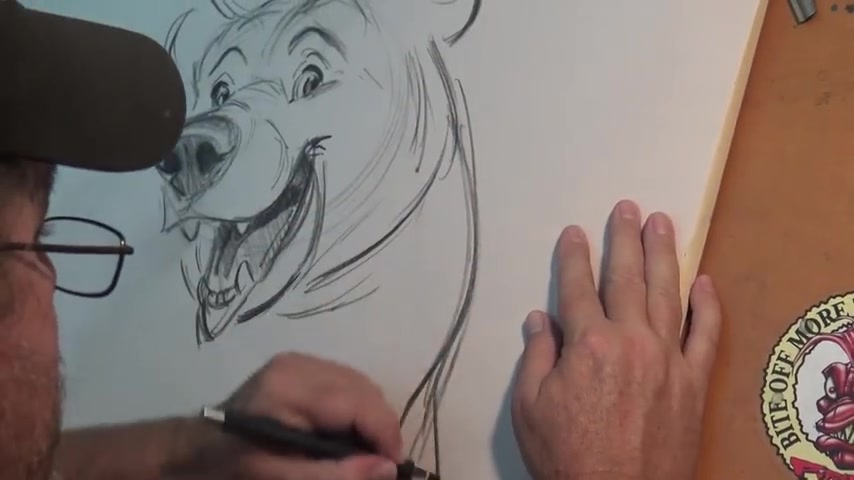
Maybe a little fur up on top , get those bare ears , big necks right in the shoulder blades .
So here what I've done even little things like this little details .
You know , I added this line in here .
It's not just a separation between the snout and the cheek , but it helps define the shape of that cheek in order to push the the feel of that smile .
Ok ?
Look for attitude .
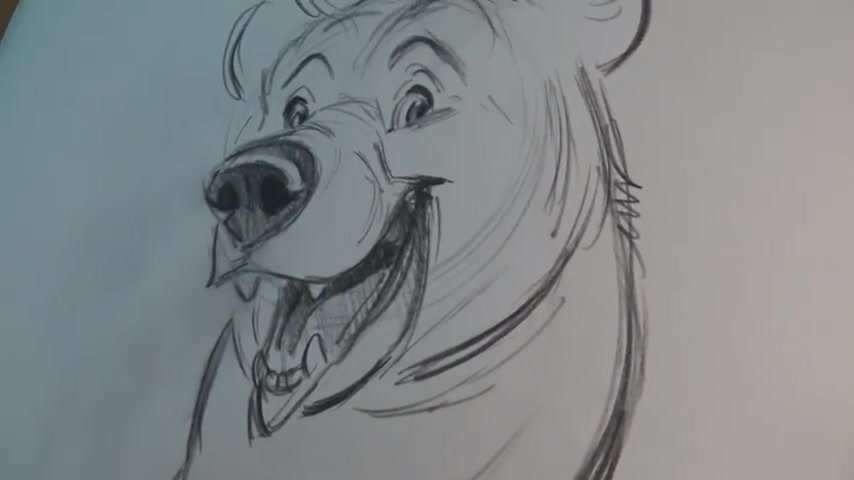
You want to make sure above beyond everything else , make sure your attitude is nice and clear and strong after that , make sure your anatomy is right .
Even with cartoony characters , you want to make sure that anatomy is clear .
Ok ?
There , there's another one .
And once again , if I wanted to , you can get in here and I can lightly shaded in if I want , I love working with this pastel like I said , get in here and have some fun with it .
Here we go .
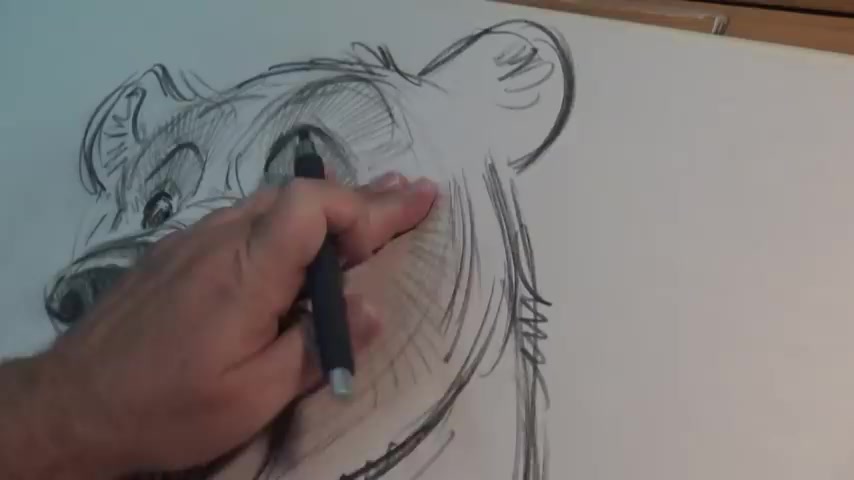
I'm always trying to make sure that I'm shading in the direction that that fur grows ok there .
So I just figured I'd do a couple of little drawings for you just to show you what I think about when I'm doing these , these drawings .
I want to make this a nice quick one for you .
But sit , go out and try , you know , get some news print , get a big nice big drawing utensil , you're gonna get dirty , you can see my hands are all dirty but get in there and just have some fun drawing and draw big and don't worry about making good or bad drawings .
But you know , make sure that you do it over and over and over again and think about that anatomy .
Imagine , you know , remember your anatomy , learn your anatomy and make sure you get those expressions nice and clear .
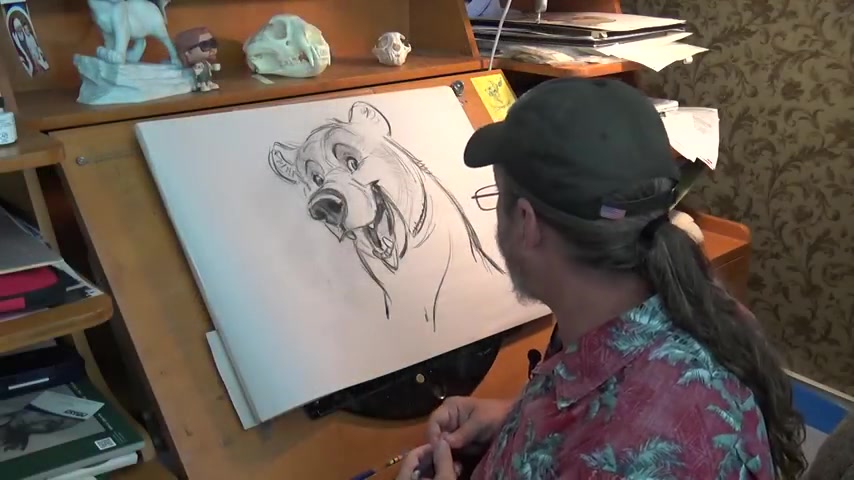
I've uh I've got a character design course over on my website where I talk about a lot , a lot of that and I get into much more depth on my website at creature art teacher dot com .
Um And it's something that I've done .
I've learned from some of the greatest uh animators at Disney .
And these are some of the techniques that I've picked up over time .
And this is these are the things that we apply to our own stuff when we're designing stuff for our films .
But anyway , uh enough of that , I just wanted to do a quick video with you guys today , do a couple of drawings and show you what I think about .
I hope you guys have a great day .
Remember we're artists and we're meant to put some beauty back into the world .
So go out there , do something good and put some beauty back into the world .
And until next time , get out there and draw , have fun and I'll talk to you later .
Thanks , bye .
Hey , thanks for watching .
If you liked what you saw , please hit the red subscribe button down below , spread the word .
And also if there's something that you're not seeing that you'd like to see , let us know .
We'd love to hear from you .
Thanks a lot .
Are you looking for a way to reach a wider audience and get more views on your videos?
Our innovative video to text transcribing service can help you do just that.
We provide accurate transcriptions of your videos along with visual content that will help you attract new viewers and keep them engaged. Plus, our data analytics and ad campaign tools can help you monetize your content and maximize your revenue.
Let's partner up and take your video content to the next level!
Contact us today to learn more.